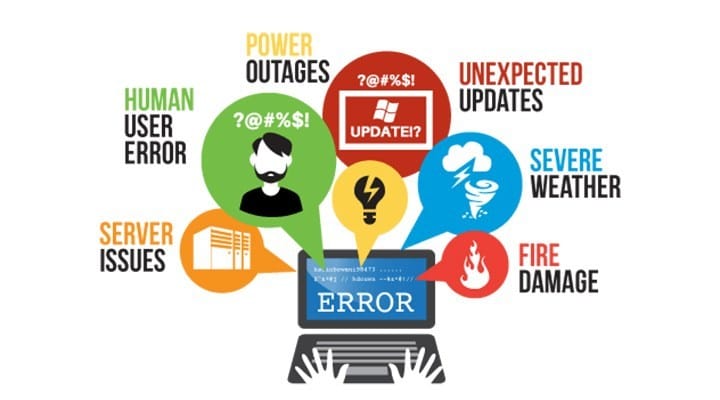How would your business cope in an emergency? If you don’t know the answer to this, you’re putting your business at risk.
You can’t predict disasters, but you can do your best to minimize the damage when it happens. One way to reduce the impact a disaster might have on your business is a continuity plan.
- What is a business continuity plan?
- Benefits of a business continuity plan?
- The challenges of business continuity
- How to develop a business continuity plan
- Who is responsible for a business continuity plan?
What is a business continuity plan (BCP)?
A business continuity plan (BCP) is a strategy that will allow your business to keep moving in the face of adversity. The plan is created with the goal to keep your business running during an unplanned disruption.
Business disruption can come in many forms, including:
- A natural disaster
- Cyberattacks
- Other threats to computer systems such as malware
- System outage/failure
- Onsite fires or floods
With 40 – 60% of small businesses never reopening after a disaster, it’s vital to have a strategy in place to manage disruptions.
Putting preventative measures in place can be the best solution. Measures like data backup checks on a cloud-based system to minimize data loss, or backup power generators to get your IT systems and other electricals up and running, can make the process easier. For example, some companies use S3 backups to ensure their data is safe and reduce the risk of data loss.
This may also mean you have an alternative operations site ready to use in the event you can’t work from your main building. This should be organized in advance, so you know where and how you’ll continue running your business, even in a crisis.
Such scenarios should be included in your business continuity plan, along with how you plan to enforce them.

Benefits of a business continuity plan
A business continuity plan comes with many benefits, and if you don’t have one then you’re putting your business at risk of being one of 40% that close forever.
Here are some of the main benefits of a business continuity plan:
Keeps your business operating during and after a major incident
Many businesses struggle to stay standing after a disaster without a plan in place. They may spend more of their time planning what to do about the disaster, extending their downtime. 90% of companies fail within a year unless they can resume operations within 5 days. This is much easier to accomplish when you’ve already calculated your next moves.
Builds customer confidence
If you’re transparent about your business processes, it instills confidence in customers. If they know you’ve got business continuity plans, they can feel reassured they’ll be taken care of, should something happen. It also shows that you’re committed to helping their business.
Has the ability to save lives
A business continuity program isn’t just about your business’s success. It’s also about employee wellbeing. When you plan fire drills and evacuation drills, you’re showing employees exactly how a disaster should be handled.
It ensures compliance with industry standards
A business continuity plan can provide proof for shareholders and key stakeholders that you’re running your business responsibly.
Helps mitigate your financial risk
By putting certain procedures in place, you’re preventing some disasters e.g. a cyber attack, from occurring. The financial losses this could incur can be avoided with an effective business continuity plan.
If you don’t have a business continuity plan, you should start by carrying out a business impact analysis. This will help you gain a deeper understanding of what your business could potentially lose, including key assets and critical IT technology. You can then identify the likelihood and potentially damaging impact if a disaster were to strike.

The challenges of business continuity
In a major disaster, you can lose everything. Business continuity during such difficult times can be tough, on both the business’s bottom line and your employees fighting to keep it afloat.
There are many challenges you can face during a disaster. Business continuity management aims to minimize all damage incurred by any emergency, but there are many challenges to overcome.
Fighting against data loss
Firstly, there’s a very real risk that you could lose important data. Many companies who rely on data will back it up every 12 to 24 hours. This means that, in a crisis, that might only lose 24 hours’ worth of data, at most.
Take law firms, for example. They deal with time-pressured projects and can’t afford any delays or setbacks, for the sake of their clients. Because they handle such sensitive information, it’s vital that it’s not lost. They may choose to backup their systems off-site every 12 hours to ensure as much data as possible is recovered in the event of an emergency.
Suddenly going remote
If your team members are no longer able to work in the office, you’ll need to find a way for them to work remotely. Communication can be particularly difficult in this instance, particularly if the team isn’t used to remote work. Your team probably has a lot on their plate, from reassuring clients to recovering data losses.
This can lead to a lot of flicking between apps, missed communications, and frustrated employees. RingCentral is an all-in-one solution that can help. And, setting up the software in advance will ensure you have the right technology in place, ready to be used if your team suddenly needs to work remotely.
You can video call, phone call, and message all in one place. What’s more, your team can work from their existing software thanks to RingCentral app integrations. You can connect your Skype, Gmail, Salesforce, Trello, and more to your RingCentral account, so your team has everything they need on one platform.
Relying on communication and project planning software isn’t ideal if your team is used to in-person collaborative work. But in the end, they may find that having everything together actually helps their workflow, and they’d rather jump on a video call for an instant response then send a long-winded email.
Keeping clients happy
You won’t be the only one panicking if a disaster occurs. Your clients will be worrying about your time-bound commitments to them, and their sensitive data. If you’ve spent time building customer relations, this will be much easier to navigate.
Keeping clients happy is one of the biggest challenges of business continuity. Simply having a great business continuity team can help to put your client’s mind at ease, especially if you’re a B2B company. If your clients know you have all the right measures in place should something happen, then they can be reassured that you’ll still be able to help them reach their targets. This can avoid the knock-on effect of impacting their workflow.
How to develop a business continuity plan
A business program plan isn’t something to be drafted overnight. It takes analysis, careful planning, and a team of people to put it together. Given that the success of your business could potentially depend on this plan, you can understand why there’s a need to get it right. Critical business functions should be outlined here.
So, what’s included in a business continuity plan? Let’s take a look at some of the essential elements.
1. Identify goals and objectives
This may seem obvious. The goal is to keep your business running, right? But actually, goals can vary depending on your business.
If you’re an IT-focused company with remote working employees, then your main goal may be minimizing data loss. But if you’re a warehouse with a huge workforce, your main goal is ensuring the safety of employees if the disaster was something life-threatening like a fire or hurricane.
You’ll also need to go into detail about the types of disasters you may encounter because they will affect your business differently. For example, finance firms could be at a higher risk of cyber attacks because of the information they handle, so need to be more aware of how they can prevent this.
On the other hand, a business in an area prone to hurricanes like Florida may need to take physical security into account, such as equipment for boarding up windows and sandbags for preventing flooding.
2. Assess key business processes
You need to develop an understanding of the business’s core needs and identify which business processes would have the most damage to the company overall. Business processes such as human resources could have a differing impact to marketing, for example.
Examine each key area of the business, and assign it as either low, medium, or critical for the company. Some questions you may want to ask are:
- How does this process support the business objectives?
- Can it lead to loss of sales/income?
- Can this decrease customer satisfaction and loyalty?
- How often does this process occur?
- What other areas of the business are dependent on this?
- Are there potential legal issues?
Eventually, you will be able to sort your business processes according to these questions. You can then include them in your business continuity plan, from low priority to top priority. This is a good indicator of how your plan needs to be structured going forward, and what key roles and responsibilities are needed to ensure your high priority processes are secured.
3. Establish a team
Ensure you’ve got a team of people who can contribute to your business operations after the disaster. This emergency management team should include key roles that your business can’t function without. For example, employees who:
- Manage sales
- Lead production processes
- Deal with clients and their accounts
- Understand most areas of the business
- Manage finances
This team will be a key driving force in getting your business back on its feet.
4. Perform a risk assessment and business impact analysis
The business impact analysis (BIA) can establish what impact potential threats could have on each area of the business. This can include the predicted recovery time objectives (RTO) and recovery point objectives (RPO). A risk assessment can run through all the types of risks the business may face. Risk management is key for the business.
Using this information, you can put together a detailed document of what to do in each potential scenario. The team can refer back to this if disaster should strike, and confidently execute the plan without too much downtime.
5. Include key external contacts
Your business may rely on a number of key external contacts who are essential to its operation. Although a small business may not have many external contacts, they still need to be notified. These may include:
- Contractors
- Service providers
- IT repair team, electricians, and consultants
- Accountants
- Suppliers
- Distributors
Keep this contact information list within the disaster recovery plan, to ensure that your employees can connect with your key external contacts and keep them informed.
6. Business recovery strategy
This should be the most in-depth part of your business continuity plan because it will include details on how you plan to maintain operations. Agree on clear strategies and responses that you can follow in various situations.
This could include recovery for the systems, stock, suppliers, resources, and equipment. Essentially anything that helps with your business operations.
Here are some key points to incorporate into your planning process:
1. Prevention and replication
What measures can you put in place to prevent a disaster? Of course, some instances simply can’t be controlled such as natural disasters. But, cyber attacks and ransomware can be saved in some cases. Once you’ve determined this, begin a replication plan.
A replication plan is how you plan to copy and move applications from one system to another. For example, having an external, off-site copy of data that’s periodically synchronized with the live version. Data centers can be a solid option for data backup.
2. Response
Once you’ve established key departments, set out a response plan for each one. Include each member’s responsibilities, and who they should report to in the case of an emergency. For example:
- Who will declare the emergency?
- Who will speak to the press?
- Who will let clients know what’s happening?
Appoint a company spokesperson that can deal with possible media interest in the incident. But always ensure that your staff and clients know first.
3. Recovery
It’s time to bounce back. After the event has been contained, you can press-on with your recovery plan. This should include guidelines for each department on how to gradually recover. Many employees expect a timeline to work around, which can be important in keeping morale and productivity high. Disaster recovery planning can help with this.
It’s at this stage you should ensure that employees are kept connected, no matter where they are working from. Hopefully, they will all be back in the office together soon, but until then, software like RingCentral can bring facilitate collaboration when they need it most.
Who is responsible for a business continuity plan?
An effective business continuity plan should be created by leaders but executed by everyone. In the disaster recovery section of the business continuity plan, there should be a list of roles and responsibilities for employees.
Your coordinator and incident commander will be tasked with activating and coordinating your organization’s disaster recovery plan. They should take expert advice from people on the ground who can help your business through the crisis.
Employees should adhere to this at all times, and play their part in getting the business back to running and smoothly as possible.
It’s never too early to create a business continuity plan
Your company needs a business continuity plan if you want to have a chance at success after a disaster. With the right plan in place, your business can still thrive after a major event. Remember to ensure you’ve got all the right tools and software to keep the team focused and productive, such as RingCentral and its many app integrations.
A business continuity plan provides you with direction and hope are the worst possible scenario. Not only is this a source of motivation, but it’s also reassurance that you can, and will, recover.
Originally published Dec 14, 2020, updated Jul 24, 2024



